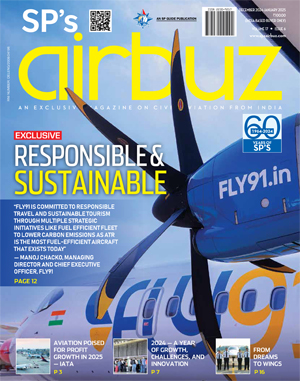ASSOCHAM - FDI Welcomed

During the Fifth International Conference on Civil Aviation, problems plaguing the Indian civil aviation industry were discussed threadbare and actions required on the part of the government were clearly enunciated
The Associat ed Chambers of Commerce and Industry of India (ASSOCHAM) hosted its Fifth International Conference on Civil Aviation on September 21, 2012, at Hotel ITC Maurya, New Delhi. Ajit Singh, the Union Minister for Civil Aviation, was the chief guest at the conference. SP Guide Publications was the official media partner.
The Inaugural Session
Welcoming the chief guest and the delegates at the conference, Rajkumar Dhoot, MP and President, ASSOCHAM, said that the Indian civil aviation industry is passing through challenging times. He complimented the Ministry of Civil Aviation for the recently announced policy of foreign direct investment (FDI) by airlines abroad into Indian carriers and described the step as “courageous, timely and meaningful”. On the issue of pricing of aviation turbine fuel (ATF), he said that foreign airlines are inclined to avoid refuelling in India due to high prices. He felt that the government should create an environment that is competitive and attractive to private investment, thereby facilitating public-private partnership. Also, the regulatory environment should nurture the growth of the industry. He hoped that the conference would provide a platform for all stakeholders to deliberate on the factors that have been impeding the growth of the Indian civil aviation industry.
K. Narayana Rao, Chairman, ASSOCHAM Civil Aviation Committee, said that the civil aviation industry, which contributed to GDP growth, is still in its nascent stages. This implies immense opportunities for growth both in the passenger and cargo segments. India also has tremendous potential to be an aviation hub and that there are lucrative opportunities in other aviation industry related activities such as maintenance repair and overhaul (MRO), general aviation, aerospace industry and training. The problems that need to be addressed urgently are reduction in cost of ATF, grant of infrastructure status to the civil aviation industry, lowering of taxes, enhancement of efficiency standards to meet the international benchmarks and facilitation of international traffic through Indian airports.
The Director at KPMG (India), Amber Dubey carried out an incisive analysis of the factors that have been impinging on the Indian civil aviation industry. He said the industry and the government need to tackle policy and regulatory challenges. The year has also seen challenges of high fuel cost, high airport charges and declining traffic. The sector needs more initiatives in areas of taxation, regulatory clarity, infrastructure development and capacity building.
Sanjay Varkey, Chief Executive Officer, Shell MRPL Aviation, said that there was steady demand growth in the industry and its sustenance called for combined effort by all stakeholders. Massive investments to develop airports are in the offing and in order to have the right infrastructure for fuel; airport operators need to be involved in the formulation of the master plan right from scratch. There will be considerable stress on environmental concerns in the future, a factor that needs to be built into the planning process. K.S. Kohli, Chairman, Frankfinn Group, highlighted the huge demand for skilled manpower in the Indian aviation industry and also catalogued the deficiencies plaguing the sector in this area. Frankfinn Group has plans for setting up 100 new training centres by the end of 2013. He called for the removal of service tax on vocational training. Joost Van Der Heijden, Head of Airline Marketing, Africa, India, South East Asia and Japan Airbus Central Entity, said that India is a strategic market for Airbus which has bagged 70 per cent of all airliners ordered since 2005. With only two per cent of the population in India taking to the air, the penetration was low and in his perception, the potential for growth was enormous. To meet the growing demand, Airbus has introduced airliners with much higher fuel efficiency and lower operating cost such as the Airbus 320neo equipped with “sharklets” and the revolutionary Airbus 350XWB soon to hit the market.
Awards
On the occasion, awards were presented by the Minister of Civil Aviation to various organisations. These included Religare for being the Most Versatile Company in aviation, Safe Express as the Best Air Cargo Company, Airbus, the Best Global Aviation Company, IndiGo, the Best National Airline, Emirates, the Best International Airline and Frankfinn, the Best Training Institute for cabin crew.
Address by the Chief Guest
In his inaugural address, the Minister of Civil Aviation said that the mood in the industry had been upbeat following the policy change in respect of FDI. Describing the industry as capital-intensive, he said that aviation was no longer an exclusive privilege of the elite and focused on a number of important issues that concerned the development of the Indian civil aviation sector. Currently, India lagged far behind the developed countries including China. Policy initiatives including modernisation of airport infrastructure and participation by the private sector during the last seven years had placed the Indian civil aviation sector on a high growth trajectory. He conceded that ATF was a problem area and said that the government was working towards granting ATF the status of ‘declared goods’ as it would then attract a uniform four per cent duty.
The Minister stated that to manage the phenomenal growth of air traffic consistent with safety, the government is planning to establish a Civil Aviation Authority in place of the Directorate General of Civil Aviation. Amongst the other initiatives were the development of low-cost airports to keep the tariff minimal at smaller airports which in turn would help render air travel affordable, restructuring of the Airports Authority of India into ANS and Civil Wing to make it more effective, efficient and professional, creation of a separate Civil Aviation Security Force, professionally trained and meant exclusively for the civil aviation sector.
One of the areas high on his priority list is to provide affordable air connectivity to remote areas of the country, the North-eastern region in particular as also to Tier-II and Tier-III cities. The Minister expressed concern that despite the high growth rate in passenger traffic over the last eight years, financial health of the Indian carriers was in a doubtful state posing a major challenge. He said that nearly half the debt was aircraft related and the rest were on account of working capital loans as also dues to airport operators and oil companies. He admitted that the operating costs were inordinately high, adversely impacting the financial situation in the airlines. He pegged the cumulative losses suffered by the airlines in the financial year 2011-12 as exceeding Rs. 10,000 crore.
The Minister stressed the need to develop India as an international hub for passenger traffic. He said that action in this regard has already been initiated, which included revisiting the policy regarding bilateral air service agreements as also rationalisation of traffic entitlements on international routes for Indian carriers. He outlined the major steps taken in this regard in the last nine months, which apart from FDI, included permitting Indian carriers to import ATF, allocation of traffic rights to private carriers to fly on international routes and creation of a separate Air Accident Bureau for investigation into accidents and suggestion of remedial measures. He also touched upon the steps taken for the turnaround of Air India including equity infusion. He added that the Rs. 30,000 crore financial support planned for Air India would be spread over the next nine years and would be contingent on their achieving the laid down performance milestones. The Minister concluded that India needed to devote considerable effort and investments in the field of development of airport infrastructure which would include construction of Greenfield airports, expansion and modernisation of existing airports and improvement in road and metro rail connectivity. The government had plans to invest Rs. 75,000 crore over the next five years on projects related to development of airports, especially the small ones, through the public-private partnership route.
Sizeable investments are required to improve air space management through better technology as also to set up comprehensive maintenance repair and overhaul (MRO) facilities. Currently, both the global aerospace majors, Boeing and Airbus, are in the process of setting up MRO facilities in India. He called upon the industry to come forward with innovative and implementable ideas for the development of civil aviation sector in India. He admitted that there was an urgent need to bring about a radical change in the business climate and to this end, the Ministry of Civil Aviation along with the Ministries of Home, Finance, Tourism, External Affairs, Commerce and Industry, Environment, Petroleum, Oil and Natural Gas, all had a major and vital role to play.
The Second Session
The session to follow was chaired by Kapil Kaul, CEO, Centre for Asia Pacific Aviation (CAPA). On the panel were Dr Manoj Singh, Advisor (Transport), Planning Commission, Government of India, Vipin Vohra, Vice-Convenor, Air Freight Council FFFAI & CMD, Continental Carriers Private Limited and Tushar Pandey, President, Strategic Initiatives, Government and Advisory, Yes Bank. The panel deliberated on the subject of “India as an Aviation Hub—Time for Collaboration”. Leading aviation hubs such as Dubai and Singapore treat aviation as a national priority and have a robust industrial, trade, maritime and tourism ecosystem that supports and benefits from the aviation sector. Close collaboration through a consultative framework involving all the Ministries of the Central Government, is the need of the hour. It emerged from the panel discussion that while the airport infrastructure in respect of the metros was improving and Delhi airport had the attributes to be an aviation hub, regional connectivity was far from satisfactory and as such the airline industry was not in a position to leverage the potential. The major infirmity with the planning process was the absence of a long-term plan. Besides, the regulatory framework was not aligned with the needs of the industry. It was brought out that infrastructure for the air cargo sector was totally inadequate.
The Last Session
The last session of the day moderated by Air Marshal (Retd) B.K. Pandey, Editor, SP’s AirBuz, was devoted to “Looking Beyond the Obvious–Aerospace, MRO, General Aviation, Cargo and Training”. For India to be an aviation hub, it needs a world class aerospace, MRO, general aviation and air cargo sectors. In his presentation, Vivek Gour, MD, Air Works, expounded the potential of India to be an MRO hub and listed the challenges, which include inadequate infrastructure, irrational tax structure and customs duty as also the absence of a clear government policy to position India as a regional MRO hub. He stated that regulations needed streamlined in order to enhance operational efficiencies. According to Chuck Pulakhandam, Embraer’s Regional Sales Director, South Asia, the essential prerequisites for India to be an aviation hub are MRO capabilities, adequate infrastructure, international outreach and domestic network. India is well placed and is moving in the right direction. New MROs are being established through global partnerships, Greenfield airports are in the pipeline, accessibility to airports is improving and international traffic increasing.
The CEO of Cargo Service Centre India Private Limited, R.G. Panicker, outlined the state of the air cargo segment of civil aviation in India. In 2011, Indian airports handled a total of 2.64 million tonnes of cargo. Domestic air cargo has over the last five years grown at a CAGR of 20 per cent and international air cargo at a CAGR of nine per cent over the last 10 years. Today, airports in India are focused on passenger traffic and as such development of air cargo infrastructure has been neglected. Enthusiasm to develop advanced air cargo terminals and handling facilities is subdued on account of the huge investments required, absence of tax concessions and uncertainty of returns. Air Marshal (Retd) V.K. Verma, Director, Indira Gandhi Rashtriya Uran Akademi, made a presentation on civil aviation training in India.





